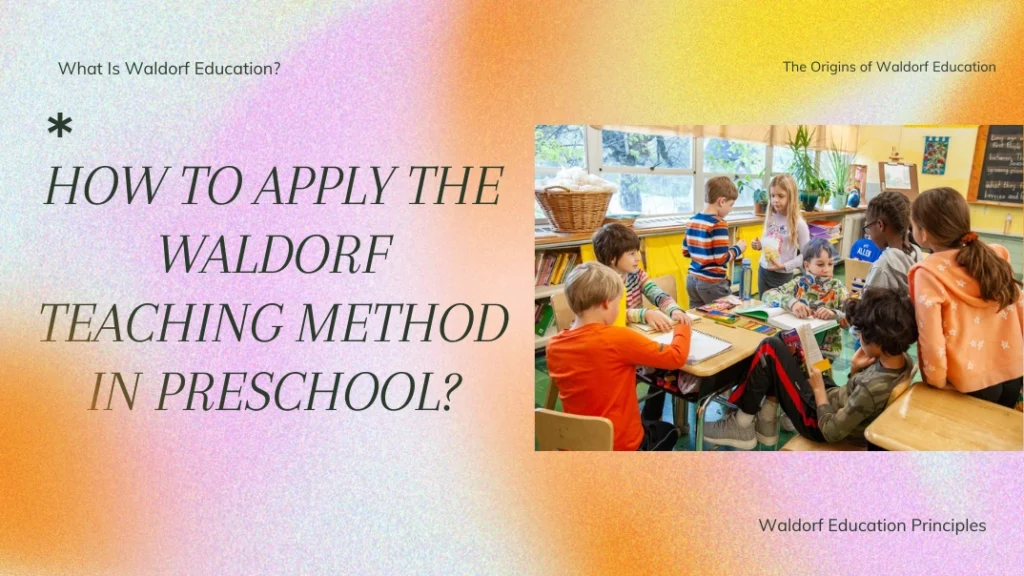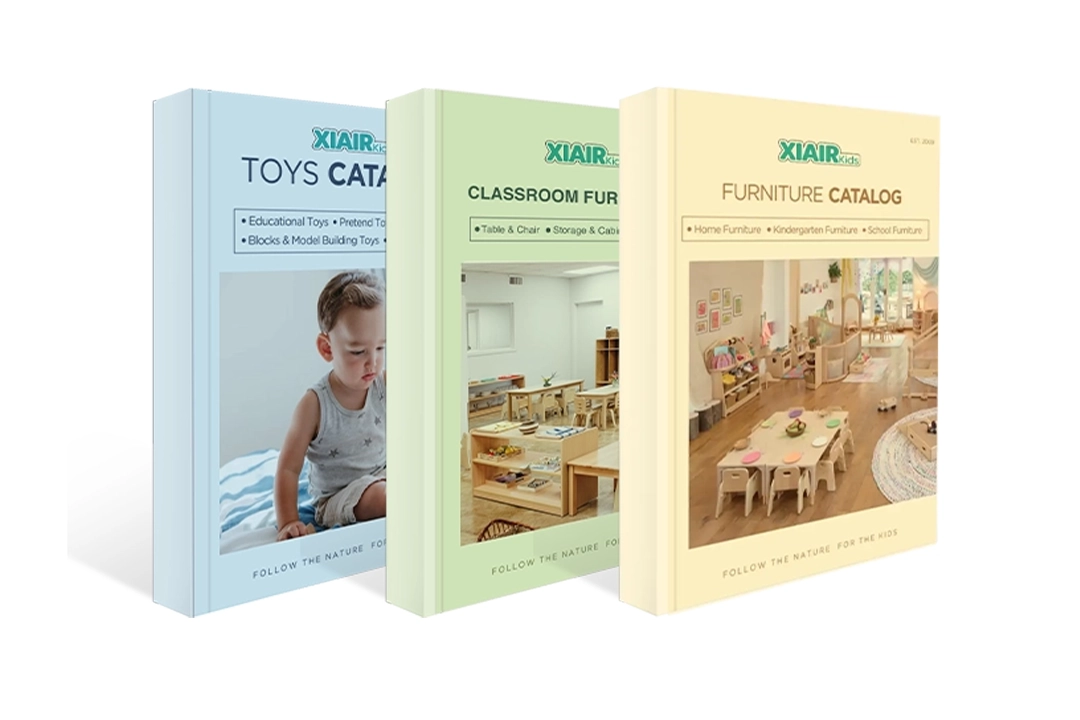Phương pháp giảng dạy Waldorf đã đạt được sự thu hút đáng kể trên toàn thế giới, đặc biệt là trong các môi trường mầm non nơi sự phát triển toàn diện của trẻ em được ưu tiên. Nhưng chính xác thì Giáo dục Waldorf, và làm thế nào để chương trình giảng dạy Waldorf có thể được triển khai hiệu quả ở trường mẫu giáo? Phương pháp này nổi bật vì tập trung độc đáo vào việc phát triển toàn diện trẻ em—trí óc, cơ thể và tinh thần—và nhấn mạnh vào sự sáng tạo, tính độc lập và kết nối với thiên nhiên. Bài viết này sẽ hướng dẫn bạn tìm hiểu các nguyên tắc của giáo dục Waldorf, ưu và nhược điểm của nó, và cách đưa các phương pháp luận của nó vào lớp học của bạn.
Phương pháp giảng dạy Waldorf, bắt nguồn từ triết lý giáo dục của Rudolf Steiner, ưu tiên học tập theo trải nghiệm, nuôi dưỡng sự sáng tạo và mối quan hệ sâu sắc với thiên nhiên. Bằng cách kết hợp giáo dục Waldorf vào trường mầm non, trẻ em được chuẩn bị học thuật và được nuôi dưỡng để trở thành những người tư duy sáng tạo, những cá nhân có trách nhiệm và những người học suốt đời.
Phương pháp giảng dạy Waldorf khác biệt với phương pháp giáo dục truyền thống ở chỗ cung cấp phương pháp tiếp cận toàn diện và cân bằng hơn đối với việc học của trẻ em. Thông qua phương pháp sư phạm Waldorf, trẻ em trải nghiệm môi trường học tập phong phú bao gồm các môn học, nghệ thuật, kỹ năng thực hành và phát triển cá nhân. Tuy nhiên, các nhà giáo dục và phụ huynh phải hiểu rằng việc áp dụng Phương pháp giảng dạy Waldorf đòi hỏi phải cam kết với các nguyên tắc cốt lõi của nó.
But how does the Waldorf Teaching Method differ from traditional models, and how can it be integrated into early childhood settings? Let’s begin by exploring what Waldorf education truly is.
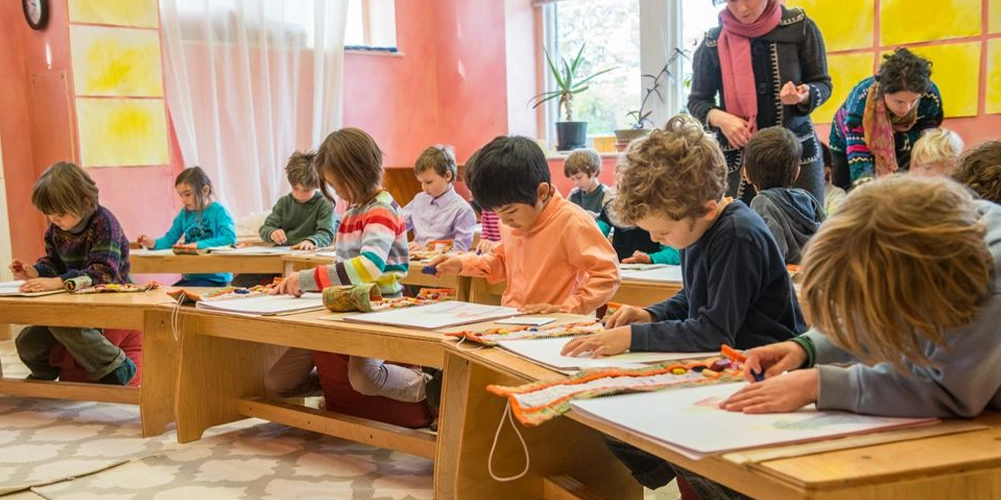
Giới thiệu
The Waldorf Teaching Method is known for its creative, child-focused approach to learning. Rooted in the ideas of Rudolf Steiner, Waldorf education is practiced in schools and kindergartens around the world. Unlike traditional classrooms, Waldorf schools value hands-on experiences, a strong sense of rhythm, and a close connection to nature. This unique way of teaching has inspired many parents and teachers to look for new ways to support each child’s natural growth and love of learning. In the following sections, we’ll explore the main ideas and principles that make the Waldorf approach so special.
Waldorf Teaching Method: Foundations and Core Principles
The Waldorf Teaching Method believes that children learn best when their mind, body, and emotions are supported together. Started by Rudolf Steiner, this approach sees every child as unique, going through different stages as they grow. In Waldorf classrooms, learning is hands-on and creative, with lots of time for play, art, and exploring nature. A steady daily and seasonal rhythm helps kids feel secure. Teachers respect each child’s pace and adjust lessons to fit the class. These simple but powerful ideas make the Waldorf Teaching Method stand out from traditional education.
Who Is Rudolf Steiner?
Rudolf Steiner was an Austrian philosopher, social reformer, and educator best known for founding the Waldorf education movement. Steiner believed that education should nurture every part of a child’s mind, body, and spirit. His ideas shaped what is now called the Waldorf Teaching Method, or Steiner education, which is practiced in many Waldorf schools around the world. Steiner’s philosophy, known as anthroposophy, is at the heart of all Waldorf education principles.
Today, Steiner and Waldorf education are closely linked. Many Waldorf teachers, parents, and schools still study Steiner’s lectures and writings to understand the unique characteristics of this approach better. The Waldorf system encourages creativity, individuality, and a strong sense of connection with the world—a vision first set out by Rudolf Steiner over a century ago.
Because of Steiner’s influence, Waldorf schools have grown globally, including in the United States, Europe, and Asia. Rudolf Steiner’s vision of education, now called the Steiner Waldorf approach, is known for blending academic subjects with the arts, practical activities, and a respect for childhood development.
Giáo dục Waldorf là gì?
Waldorf education, sometimes called the Waldorf Teaching Method or Steiner education, is a way of teaching that focuses on the whole child. This method is used in Waldorf schools, Waldorf kindergartens, and even public Waldorf education programs. At its core, Waldorf education encourages children to learn by doing, with lots of play, art, music, and hands-on activities.
The Waldorf classroom looks and feels different from traditional schools. There are often wooden toys, natural materials, and creative spaces for children to explore. The curriculum follows the natural stages of childhood and values each child’s pace. This unique learning environment is one of the defining features of Waldorf pedagogy and what sets the Waldorf method apart from other education systems.
Families are drawn to the Waldorf approach because it emphasizes imagination, practical skills, and a love for learning that lasts a lifetime. The Waldorf education philosophy respects the importance of routine, rhythm, and a strong connection between home and school. Today, there are thousands of Waldorf schools and Steiner schools worldwide, each dedicated to helping children grow into thoughtful, confident, and compassionate adults.
Đừng chỉ mơ ước, hãy thiết kế nó! Hãy cùng trò chuyện về nhu cầu nội thất tùy chỉnh của bạn!
Nguồn gốc của giáo dục Waldorf
Trường Waldorf đầu tiên được thành lập vào năm 1919 dành cho con em của công nhân nhà máy thuốc lá Waldorf-Astoria ở Stuttgart, Đức. Rudolf Steiner hình dung ra một hệ thống giáo dục phát triển khả năng trí tuệ và năng lực nghệ thuật, thực hành và đạo đức của học sinh. Hệ thống giáo dục Waldorf được thiết kế để năng động và linh hoạt, cho phép giáo viên tự do tạo ra các bài học phù hợp với các giai đoạn phát triển cụ thể của học sinh. Mục tiêu là bồi dưỡng những cá nhân toàn diện có khả năng đóng góp có ý nghĩa cho xã hội.
Giáo dục Steiner và Waldorf từ đó đã mở rộng trên toàn cầu, với hàng ngàn trường Waldorf hiện đang hoạt động trên toàn thế giới. Mỗi trường Waldorf đều áp dụng Phương pháp giảng dạy Waldorf bằng cách điều chỉnh các nguyên tắc của Steiner để phù hợp với bối cảnh văn hóa, địa lý và xã hội của học sinh. Cho dù ở trường nông thôn hay thành thị, chương trình giảng dạy Waldorf đều tập trung vào việc phát triển toàn diện trẻ em thông qua các hoạt động học thuật và phi học thuật.
Ngày nay, các trường giáo dục Waldorf trải dài trên nhiều châu lục, cung cấp giáo dục từ mẫu giáo đến trung học. Các trường này tiếp tục tuân theo các nguyên tắc mà Rudolf Steiner đặt ra, tập trung vào sự phát triển toàn diện của mỗi trẻ.

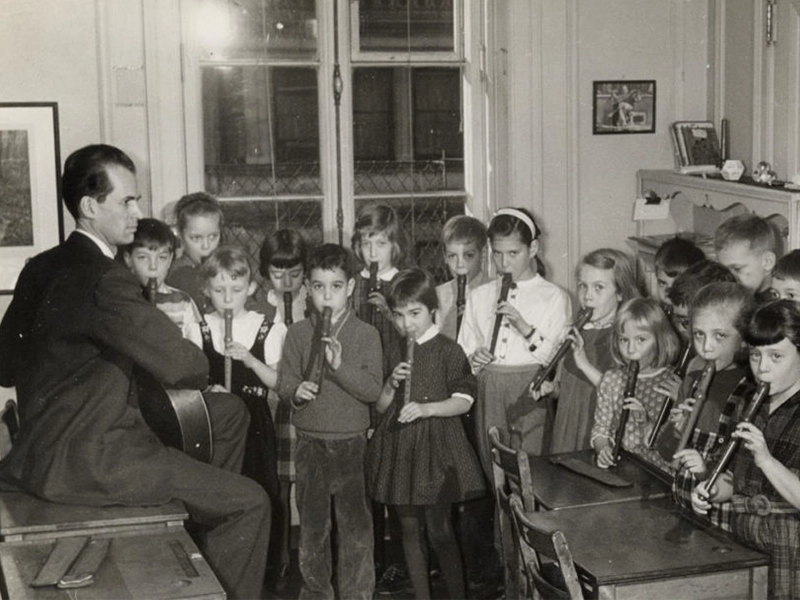
Nền tảng của giáo dục Waldorf
Giáo dục Waldorf được xây dựng dựa trên niềm tin rằng trẻ em trải qua ba giai đoạn phát triển riêng biệt: thời thơ ấu, thời thơ ấu giữa và tuổi vị thành niên. Mỗi giai đoạn này được đặc trưng bởi các nhu cầu phát triển cụ thể, được giải quyết thông qua chương trình giảng dạy Waldorf theo cách hỗ trợ sự phát triển tự nhiên và khả năng học tập của trẻ.
Thời thơ ấu
Trong thời thơ ấu, giáo dục Waldorf tập trung vào việc học thông qua chơi, bắt chước và trải nghiệm giác quan. Môi trường lớp học Waldorf được thiết kế đơn giản và chứa đầy các vật liệu tự nhiên như đồ chơi bằng gỗ và len, giúp nuôi dưỡng mối liên hệ với thiên nhiên. Giai đoạn giáo dục Waldorf này cho phép trẻ phát triển cơ thể và giác quan thông qua các nhiệm vụ có ý nghĩa như nấu ăn, dọn dẹp và làm vườn.
Các khía cạnh quan trọng của chương trình giáo dục mầm non Waldorf bao gồm:
- Trò chơi sáng tạo: Play-based learning is the cornerstone of Waldorf pedagogy at this stage. Children are encouraged to engage in imaginative play with simple, natural toys that inspire creativity.
- Kể chuyện và nhịp điệu:Kể chuyện truyền miệng, bài hát và thơ ca đóng vai trò trung tâm trong các hoạt động hàng ngày, tạo nên cấu trúc nhịp điệu giúp trẻ có cảm giác an toàn.
- Kỹ năng sống thực tế:Trẻ em tham gia các nhiệm vụ như nướng bánh mì, dọn dẹp lớp học và trồng cây trong vườn, giúp phát triển các kỹ năng vận động và nuôi dưỡng tính độc lập.
Phương pháp giảng dạy Waldorf nhấn mạnh vào việc nuôi dưỡng năng lực thể chất, cảm xúc và trí tưởng tượng của trẻ trong giai đoạn này. Thông qua các nhiệm vụ thực tế và trò chơi, trẻ em trải nghiệm thế giới và phát triển các kỹ năng nền tảng hỗ trợ việc học tập trong tương lai. Lớp học Waldorf ở cấp độ này cố tình không có các tiện ích hoặc màn hình công nghệ cao, điều này phù hợp với triết lý Waldorf rằng trẻ em nên tương tác trực tiếp hơn với môi trường xung quanh.
In a Waldorf preschool, the teacher plays a crucial role in modeling behaviors for the children to imitate. This highlights another fundamental principle of the Waldorf Teaching Method: children learn best through example, not through direct instruction at such an early stage. Waldorf classrooms are often described as serene and nurturing spaces, encouraging imaginative play and exploration.
Tuổi thơ trung niên
Ở các trường Waldorf, việc học trí tuệ bắt đầu hình thành ở giai đoạn giữa thời thơ ấu. Tuy nhiên, theo triết lý của Steiner, phương pháp giáo dục Waldorf vẫn nhấn mạnh việc học trải nghiệm và thể hiện nghệ thuật như là phương tiện chính cho sự phát triển trí tuệ.
Các yếu tố chính của chương trình giảng dạy Waldorf cho giai đoạn này bao gồm:
- Khối bài học chính:Các môn học như toán, văn học và khoa học được giảng dạy theo từng khối chuyên sâu kéo dài trong nhiều tuần, cho phép học sinh đắm mình hoàn toàn vào chủ đề.
- Hội nhập nghệ thuật:Mọi môn học trong lớp học Waldorf đều được giảng dạy thông qua các phương pháp nghệ thuật—vẽ, sơn, kể chuyện và kịch được sử dụng để làm cho những ý tưởng phức tạp trở nên hữu hình và dễ hiểu hơn.
- Hoạt động thực tế: In line with the Waldorf philosophy, children also engage in practical tasks, such as handicrafts and woodworking, that integrate cognitive and physical skills.
Trong giai đoạn này, triết lý của trường Waldorf thúc đẩy sự phát triển trí tuệ cảm xúc, nhấn mạnh vào sự sáng tạo, trí tưởng tượng và tinh thần hợp tác.
Phương pháp giảng dạy Waldorf trong thời thơ ấu giúp trẻ phát triển về mặt cảm xúc và trí tuệ, chuẩn bị cho trẻ những yêu cầu học tập khắt khe hơn của tuổi vị thành niên. Giáo viên tại các trường Waldorf được biết đến là ở lại với cùng một nhóm học sinh trong nhiều năm, nuôi dưỡng các mối quan hệ bền chặt, tin tưởng góp phần tạo nên môi trường học tập ổn định. Sự liên tục này là một đặc điểm quan trọng của hệ thống giáo dục Waldorf, phân biệt nó với các trường học truyền thống, nơi học sinh thường xuyên thay đổi giáo viên.
Giáo dục Waldorf cũng nhấn mạnh vào việc chơi ngoài trời và kết nối với thiên nhiên trong thời thơ ấu. Các hoạt động ngoài trời hàng ngày, đi bộ trong thiên nhiên và các chuyến đi thực tế được tích hợp vào chương trình giảng dạy Waldorf để giúp trẻ em kết nối với môi trường, phản ánh thêm các giá trị cốt lõi của trường Waldorf.
Tuổi vị thành niên
Khi trẻ em bước vào tuổi vị thành niên, chương trình giảng dạy Waldorf chuyển sang bồi dưỡng tư duy phản biện, phản biện đạo đức và trách nhiệm xã hội. Các trường Waldorf ở giai đoạn này nhấn mạnh vào việc học tập độc lập, tham gia cộng đồng và theo đuổi sở thích cá nhân.
Các khía cạnh chính của giai đoạn này bao gồm:
- Tư duy phản biện:Thanh thiếu niên được khuyến khích tham gia vào các cuộc tranh luận triết học, các dự án nghiên cứu và các nhiệm vụ phân tích để phát triển khả năng lý luận và phản xạ của mình.
- Học tập dịch vụ:Tuân theo các nguyên tắc của Waldorf, học sinh tham gia vào các dự án dịch vụ cộng đồng nhấn mạnh vào trách nhiệm xã hội và nhận thức đạo đức.
At this stage, the Waldorf Teaching Method helps adolescents understand their role within the community and the wider world. Waldorf teachers become mentors, supporting students in developing independence and a strong sense of purpose.
TRONG Trường Waldorf, tuổi vị thành niên là thời gian tự khám phá và phát triển bản thân. Chương trình giảng dạy được thiết kế để thử thách học sinh về mặt trí tuệ và cảm xúc, hướng dẫn các em trở thành những cá nhân đồng cảm, chu đáo, sẵn sàng đóng góp tích cực cho xã hội. Các trường giáo dục Waldorf trên toàn thế giới tiếp tục thực hiện các nguyên tắc này để đảm bảo học sinh tốt nghiệp với nền giáo dục toàn diện vượt xa thành tích học tập đơn thuần.
Lớp học lý tưởng của bạn chỉ cách bạn một cú nhấp chuột!
Nguyên tắc giáo dục Waldorf
Một số nguyên tắc cốt lõi định nghĩa triết lý giáo dục Waldorf. Những nguyên tắc này hướng dẫn cách giáo viên tương tác với học sinh và định hình chương trình giảng dạy để thúc đẩy trải nghiệm học tập toàn diện.
Con Người như một Thực Thể Tâm Linh
Một trong những niềm tin cốt lõi trong phương pháp sư phạm Waldorf là trẻ em là những sinh vật tâm linh có số phận riêng biệt. Phương pháp giảng dạy Waldorf khuyến khích sự phát triển tâm linh của trẻ, không theo nghĩa tôn giáo, mà bằng cách nuôi dưỡng cảm giác ngạc nhiên và tôn kính cuộc sống. Các lớp học Waldorf được thiết kế để truyền cảm hứng cho sự kính sợ thông qua vẻ đẹp của vật liệu tự nhiên, nhịp điệu theo mùa và biểu hiện nghệ thuật.
Phương pháp giảng dạy Waldorf gắn chặt với nhịp điệu của thế giới tự nhiên, với nhịp điệu hàng ngày, hàng tuần và theo mùa giúp tạo ra một môi trường an toàn, có thể dự đoán được cho trẻ nhỏ. Ví dụ, trong trường mẫu giáo Waldorf, các bài hát, câu thơ và hoạt động theo mùa giúp trẻ kết nối với dòng chảy tự nhiên của thời gian. Khía cạnh tâm linh của giáo dục Waldorf nhấn mạnh vào sự phát triển tiềm năng và ý thức về bản thân độc đáo của mỗi trẻ, giúp trẻ phát triển thành những cá nhân đồng cảm, có trách nhiệm với xã hội.
Tự do trong giảng dạy
Trong hệ thống Waldorf, giáo viên được trao quyền tự do đáng kể để truyền đạt bài học. Phương pháp giáo dục Waldorf cho phép các nhà giáo dục điều chỉnh chương trình giảng dạy theo nhu cầu và sở thích của học sinh, đảm bảo rằng việc học vẫn hấp dẫn và phù hợp. Quyền tự do sáng tạo này phân biệt các trường Waldorf với các hệ thống giáo dục truyền thống, nơi chương trình giảng dạy cứng nhắc có thể hạn chế các trải nghiệm học tập cá nhân.
Giáo viên Waldorf được trao quyền tự chủ để tạo ra các bài học khơi dậy sự tò mò và sáng tạo. Họ sử dụng những quan sát của mình về sự phát triển của trẻ em để hướng dẫn nội dung và phương pháp giảng dạy. Sự tự do này cho phép giáo viên tại các trường Waldorf cá nhân hóa trải nghiệm học tập cho từng trẻ, biến giáo dục thành một quá trình hữu cơ và phát triển thay vì là một quá trình chuẩn hóa.
Phương pháp giảng dạy Waldorf coi trọng vai trò của giáo viên như một nhà giáo dục và người hướng dẫn sáng tạo, tạo ra môi trường học tập năng động, nhạy bén, khuyến khích học sinh khám phá sở thích và tài năng của mình.
Học tập trải nghiệm và xây dựng mối quan hệ
Giáo dục Waldorf ưu tiên học tập theo trải nghiệm, nơi trẻ em tham gia vào các môn học thông qua các hoạt động thực hành. Cho dù là vẽ tranh, làm vườn hay kể chuyện, học sinh trong lớp học Waldorf đều học bằng cách thực hành. Ngoài ra, mối quan hệ chặt chẽ giữa giáo viên và học sinh là một đặc điểm khác của phương pháp sư phạm Waldorf. Giáo viên thường ở lại với cùng một nhóm học sinh trong nhiều năm, thúc đẩy mối liên kết sâu sắc giúp nâng cao trải nghiệm học tập.
Phương pháp giảng dạy Waldorf rất coi trọng các mối quan hệ hình thành trong lớp học. Việc có cùng một giáo viên hướng dẫn học sinh trong nhiều năm sẽ xây dựng mối quan hệ tin tưởng và hiểu biết chặt chẽ, tạo ra một môi trường hỗ trợ nơi học sinh cảm thấy an toàn để thể hiện bản thân và chấp nhận rủi ro trong quá trình học tập. Sự liên tục này rất cần thiết cho hệ thống giáo dục Waldorf, thúc đẩy sự ổn định và an toàn về mặt cảm xúc trong suốt hành trình đến trường của trẻ.
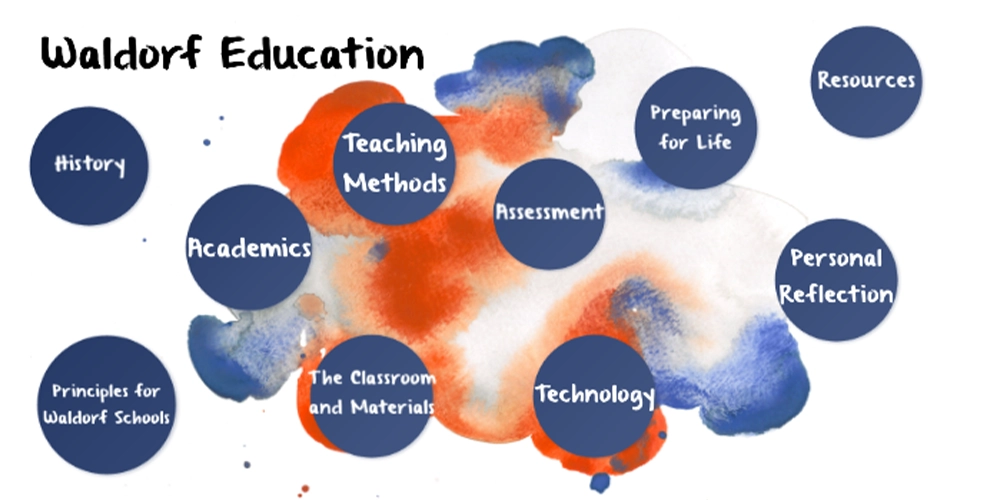
Ưu và nhược điểm của phương pháp giảng dạy Waldorf
Khi xem xét hệ thống giáo dục Waldorf cho các cơ sở mầm non, việc đánh giá các điểm mạnh và thách thức tiềm ẩn của nó là điều cần thiết. Dưới đây là cái nhìn toàn diện về ưu và nhược điểm của phương pháp Waldorf.
Ưu điểm:
- Học tập thực hành và phù hợp với lứa tuổi
Phương pháp giảng dạy Waldorf nhấn mạnh vào việc học thông qua trải nghiệm, xúc giác, cho phép trẻ tham gia vào các hoạt động phù hợp với giai đoạn phát triển của mình. - Học tập dựa trên trò chơi
Vui chơi là một khía cạnh quan trọng của việc học ở trường mẫu giáo Waldorf, thúc đẩy khả năng sáng tạo, phát triển nhận thức và kỹ năng xã hội. - Công nghệ không được sử dụng trong lớp học.
Mô hình giáo dục Waldorf cố tình giảm thiểu việc sử dụng công nghệ, khuyến khích trẻ em tương tác trực tiếp với thế giới xung quanh. - Học sinh học cách đóng vai trò tích cực trong việc học tập của mình
Phương pháp Waldorf khuyến khích trẻ em tự học, nuôi dưỡng tính độc lập và tò mò. - Trường Waldorf đào tạo ra những cá nhân toàn diện.
Phương pháp giáo dục toàn diện Waldorf hỗ trợ phát triển năng lực trí tuệ, cảm xúc và nghệ thuật, giúp trẻ trở thành những cá nhân toàn diện. - Những cá nhân được giáo dục theo phương pháp Waldorf có niềm đam mê học tập suốt đời
Những người tốt nghiệp trường Waldorf thường duy trì tình yêu học tập sâu sắc trong suốt cuộc đời, vì triết lý Waldorf khơi dậy sự tò mò và cảm giác ngạc nhiên.
Nhược điểm:
- Thiếu tập trung vào học thuật
- Những người chỉ trích nền giáo dục Waldorf cho rằng việc chậm trễ đưa vào các môn học chính thức như đọc và toán có thể khiến học sinh gặp bất lợi so với các bạn cùng lứa trong môi trường truyền thống.
- Giáo viên dạy cùng một đứa trẻ trong nhiều năm
- Mặc dù điều này thúc đẩy mối quan hệ bền chặt nhưng có thể hạn chế khả năng tiếp xúc của sinh viên với các phong cách và quan điểm giảng dạy khác nhau.
- Sử dụng công nghệ hạn chế
- Mặc dù nhiều phụ huynh đánh giá cao phương pháp giáo dục không sử dụng công nghệ của Waldorf, nhưng những người khác lại cảm thấy phương pháp này có thể khiến học sinh không được chuẩn bị cho một thế giới do công nghệ thúc đẩy.
Waldorf education schools are often criticized for their reluctance to incorporate technology into the classroom. While this is intended to foster deeper personal and creative engagement, some parents and educators worry that children in Waldorf schools may not develop the necessary digital literacy skills for the modern world. Despite this, many proponents of the Waldorf Teaching Method argue that focusing on creativity and problem-solving skills in Waldorf schools adequately prepares students for future challenges.

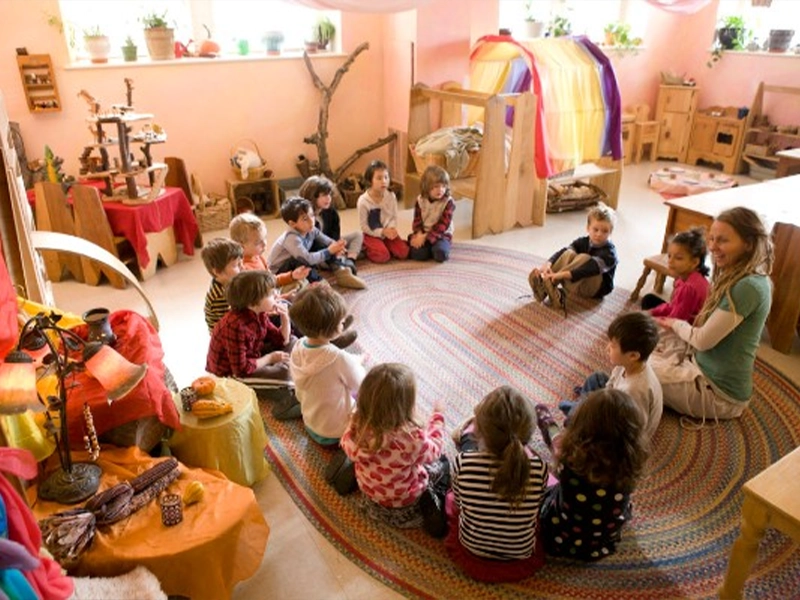
Creating a Waldorf-Inspired Learning Environment
A Waldorf-inspired classroom is carefully designed to reflect the heart of the Waldorf Teaching Method. Every detail—from the color of the walls to the choice of furniture—plays a role in supporting children’s learning and well-being. Let’s look at the most critical aspects of creating a space where Waldorf education can genuinely thrive.
Why the Classroom Environment Matters in Waldorf Education
In the Waldorf Teaching Method, the môi trường lớp học is seen as an extension of the learning process. Waldorf schools understand that children absorb more than just what is taught—they are deeply influenced by their surroundings every day.
- The Classroom as the “Third Teacher”:
In Waldorf education, the physical classroom is not just a backdrop but an active part of the teaching team. The space gently guides children’s behavior and mindset. When a Waldorf classroom is organized with intention, it naturally supports focus, creativity, and collaboration among students. This is why many Waldorf schools invest in carefully planned layouts, soft lighting, and uncluttered areas. - Calm, Inviting Spaces:
Waldorf classrooms avoid loud colors or harsh lights. Instead, they feature gentle hues, natural sunlight, and plenty of quiet corners. This setting helps children feel safe and comfortable, which in turn encourages them to explore, ask questions, and try new things. A calm environment is a hallmark of Waldorf education and is closely connected to the success of the Waldorf teaching approach. - Movement and Flexibility:
Unlike traditional classrooms, a Waldorf classroom is not fixed. Furniture can be moved to make space for group work, circle time, or imaginative play. Flexible layouts promote both independence and cooperation. Children are invited to participate in arranging their classroom, which teaches responsibility and respect for shared spaces—a key value in Waldorf education schools. - Connection to the Senses:
Every element, from the texture of a wool rug to the scent of wooden shelves, is chosen to support children’s sensory development. The Waldorf learning method encourages teachers to use materials that invite touch and interaction. These sensory experiences ground children in the present moment and help them feel connected to their environment. - Supporting the Waldorf Curriculum:
A thoughtfully designed classroom supports all parts of the Waldorf curriculum. Whether it’s storytelling in a cozy corner, painting at a sunlit table, or gathering for morning songs, the environment enhances every learning experience. The Waldorf Teaching Method reminds us that children thrive when their classrooms are as nurturing and inspiring as the lessons themselves.
Choosing the Right Materials and Furniture for Waldorf Classrooms
Selecting the right furniture and materials is a key part of creating an authentic Waldorf classroom. The choices you make will shape not just the look and feel of the school but also how children learn and interact each day.
- Natural Materials at the Heart of Waldorf Design:
Waldorf schools and kindergartens prefer natural materials like wood, wool, and cotton for furniture and classroom items. Solid wood chairs, child-sized tables, and natural wooden shelves are common choices. These pieces are not only durable and safe but also help children connect with the natural world, a core idea in Waldorf education philosophy. You’ll often find wool rugs, cotton curtains, and handwoven baskets as well. - Child-Sized and Ergonomic Furniture:
The Waldorf Teaching Method values independence, so furniture is chosen with the child in mind. Look for low tables, small wooden chairs, open bookcases, and coat racks placed at child height. Ergonomic design supports good posture and healthy movement, which is essential in Waldorf pedagogy. - Simplicity and Versatility:
In Waldorf classrooms, furniture and materials are kept simple to encourage open-ended play. Play stands (wooden frames for draping silks or creating imaginative scenes) can become a puppet theater, shop, or reading nook. Art easels, large woven baskets for blocks, and stackable stools all offer multiple uses and support the Waldorf learning approach. - Safety and Sustainability:
Safety is always a priority. Waldorf education schools select furniture with smooth edges, stable bases, and non-toxic finishes. Sustainable production is also essential, aligning with Waldorf’s principles of respect for the earth. Consider eco-friendly đồ nội thất bằng gỗ, bamboo storage shelves, or FSC-certified products for your classroom. - Aesthetic Harmony:
Every item in a Waldorf classroom is chosen to support a sense of beauty and order. Coordinated colors, soft fabrics, and natural textures create a peaceful atmosphere. You’ll often see wool floor rugs, cotton cushions, and nature-inspired decorative items in the space.
Product Checklist for a Waldorf Classroom
| Loại sản phẩm | Description / Use | Waldorf Features |
|---|---|---|
| Child-Sized Wooden Tables | For group work, meals, and art activities | Natural materials, ergonomic design |
| Ghế gỗ | Supports proper posture and independence | Sturdy, child-sized, easy to move |
| Open Shelving/Bookcases | Storage for books, toys, and classroom materials | Low height for easy access, natural wood |
| Play Stands / Puppet Theaters | For imaginative play and scene creation | Versatile, encourages creativity |
| Art Easels & Craft Tables | Painting, drawing, and crafts | Adjustable, easy to clean |
| Large Woven Baskets | Organize blocks, toys, and art supplies | Soft, natural fibers, flexible use |
| Wool or Cotton Area Rugs | Define group spaces and reading corners | Soft texture, natural colors |
| Floor Cushions & Beanbags | Create cozy, inviting reading or rest areas | Comfortable, safe materials |
| Nature Tables/Display Shelves | Show seasonal items and nature collections | Connects classroom to nature |
| Coat Racks at Child Height | Foster independence and order | Proper height for self-care |
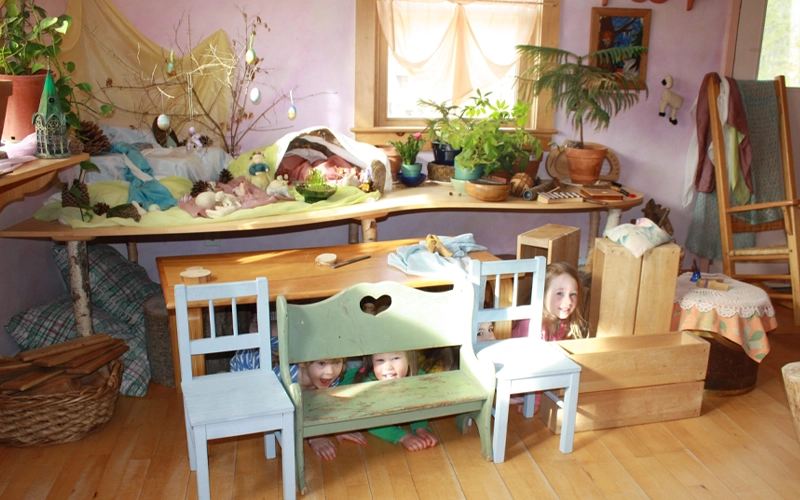
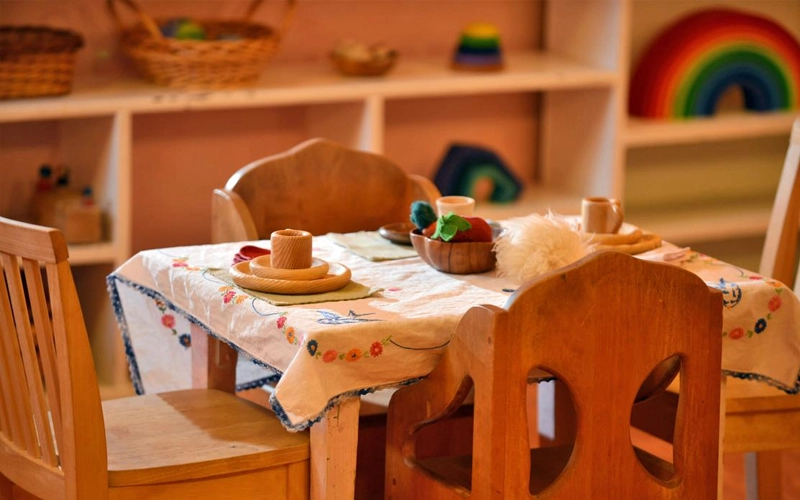
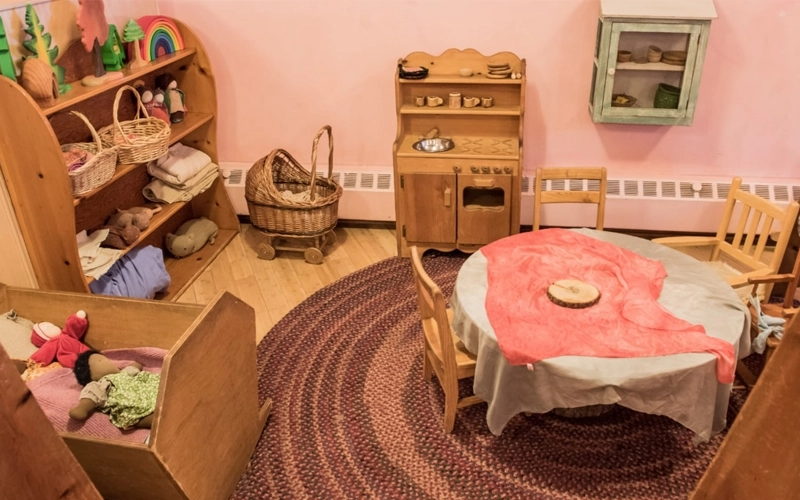
Designing Open-Ended Play and Learning Areas
A key feature of the Waldorf Teaching Method is making room for open-ended play and hands-on exploration. In Waldorf classrooms, teachers use thoughtful layouts and versatile products to encourage imagination and social growth.
- Flexible Spaces for Imaginative Play:
Waldorf schools make great use of play stands, which can become a shop, theater, or cozy hideaway with just a few silk scarves or pieces of fabric. Wooden building blocks, stacking crates, and simple tables let children design their play worlds. - Simple, Multi-Use Materials:
Toys and props in Waldorf classrooms are chosen for their versatility. Waldorf dolls, wooden animals, woven baskets, felt mats, and silk scarves allow kids to invent their own stories, build scenery, and explore movement. This supports the Waldorf philosophy of learning through doing. - No Screens or Battery Toys:
Following Waldorf’s pedagogy, there are no electronic gadgets in the classroom. Instead, children engage deeply with wooden puzzles, nature-inspired objects, and creative craft supplies. - Zones for Different Activities:
Spaces are set up for a variety of uses—a reading corner with floor cushions and a low bookshelf, a building area with tree slices and baskets of loose parts, an art table with paints and clay, and a puppet stage for storytelling. - Encouraging Social and Emotional Growth:
With these open-ended resources, children naturally learn to cooperate, share, and communicate, which is a hallmark of Waldorf education.
Typical Waldorf Play & Learning Products:
| Sản phẩm | Sử dụng trong lớp học |
|---|---|
| Play Stands | Building forts, shops, puppet theaters |
| Wooden Building Blocks | Creative construction, counting, and sorting |
| Silk Scarves & Fabrics | Costumes, movement, scenery for imaginative play |
| Waldorf Dolls & Puppets | Storytelling, role play, social learning |
| Woven Baskets | Storing toys, natural objects, or art supplies |
| Floor Cushions & Rugs | Cozy areas for reading, resting, or circle time |
| Art Easels & Craft Tables | Painting, drawing, collaborative projects |
| Low Shelves & Bookcases | Accessible storage, book display for kids |
| Tree Slices & Loose Parts | Building, stacking, nature-based exploration |
These open-ended products help bring the Waldorf Teaching Method to life, turning any classroom into a place where creativity, independence, and discovery are part of everyday life.
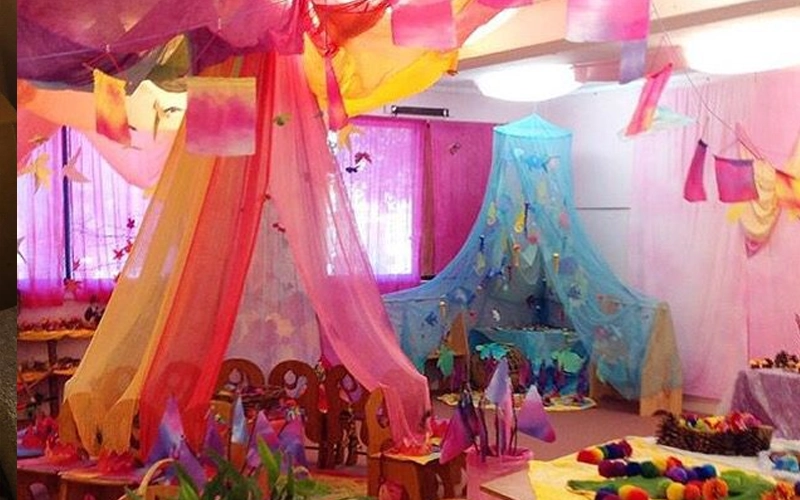


Bringing Nature and Seasonal Rhythm Into the Classroom
The Waldorf Teaching Method places a strong focus on connecting children with nature and honoring the rhythm of the seasons. In a Waldorf classroom, the environment is carefully designed to reflect the cycles of the natural world, a core part of Waldorf pedagogy and philosophy.
- Nature Tables and Seasonal Displays:
In Waldorf schools and Waldorf education preschools, a nature table is a central feature. Children collect and display seasonal items like stones, leaves, and flowers, turning the classroom into a living reflection of nature’s changes. This hands-on activity is a hallmark of the Waldorf Teaching Method and supports the Waldorf learning approach by encouraging observation and respect for the earth. - Maximizing Natural Light and Plant Life:
A typical Waldorf classroom is filled with sunlight and fresh air, supporting children’s well-being and learning. Plants and indoor gardens are common in Waldorf education schools, helping students learn to care for living things. Teachers in Waldorf schools may use window crystals or sun catchers to bring natural colors and beauty into the space. - Seasonal Crafts and Natural Decorations:
The Waldorf curriculum includes many handcrafts using wool, felt, and wood. Children create decorations and art projects that celebrate each season, such as spring garlands or autumn mobiles. This creative activity is central to Waldorf methodology and helps build the rhythm of the Waldorf classroom. - Outdoor Learning and Nature Walks:
The Waldorf approach encourages regular time outside, whether in a school garden or on nature walks. These experiences are deeply integrated into the Waldorf education system, helping children learn through direct experience and reinforcing the values of the Waldorf Teaching Method. - Daily and Weekly Rhythms:
Teachers following the Waldorf education philosophy plan routines and seasonal festivals in sync with the rhythms of nature. Morning circles, weekly baking, and seasonal celebrations are all classic examples of the Waldorf system in action.
In every Waldorf classroom, these natural elements and rhythms make learning come alive. The Waldorf Teaching Method teaches children to notice the world around them and feel part of something greater—an essential part of Waldorf education’s unique characteristics.
Lớp học lý tưởng của bạn chỉ cách bạn một cú nhấp chuột!
Supporting Independence and Creativity Through Layout
A key goal of the Waldorf Teaching Method is to help children become independent thinkers and creative problem solvers. The way a Waldorf classroom is arranged can make a big difference in supporting both independence and creativity for every child.
- Accessible Furniture and Materials:
In Waldorf schools, all tables, chairs, shelves, and storage units are set at a child-friendly height. This encourages children to find what they need, tidy up after activities, and make their own choices throughout the day. The Waldorf classroom is designed to empower children and promote self-confidence, which is a core principle of the Waldorf education philosophy. - Open Layouts for Free Movement:
The Waldorf Teaching Method recommends open floor plans with clear pathways. Furniture is arranged so children can move freely between activity zones, such as play areas, reading corners, and art tables. This freedom supports creative exploration, collaboration, and physical coordination, all of which are valued in Waldorf pedagogy. - Choice and Flexibility:
The Waldorf approach allows children to choose where and how they work or play. Having multiple spaces—like a quiet corner for reading, a large table for group art, or an open area for building—lets students follow their interests and express their individuality. This supports the unique characteristics of the Waldorf learning method. - Self-Directed Activities:
Teachers using the Waldorf education model encourage self-initiated projects and open-ended tasks. Materials are displayed in an organized and inviting way so children can start activities on their own and clean up when finished. This routine helps students develop responsibility and a sense of ownership in the classroom. - Encouraging Collaboration:
While independence is key, the layout also fosters teamwork. Group seating, shared materials, and open spaces for circle time or performances give students the chance to work together, share ideas, and solve problems collectively—a central aspect of the Waldorf education system.
With a thoughtful classroom layout, the Waldorf Teaching Method creates an environment where children develop life skills, self-motivation, and creative confidence—qualities that last far beyond the preschool years.
Integrating Outdoor Learning Areas
In the Waldorf Teaching Method, learning doesn’t end at the classroom door. Outdoor spaces are seen as vital extensions of the Waldorf school environment, offering children fresh air, movement, and endless opportunities to connect with nature.
- Design Outdoor Classrooms with Nature in Mind
Waldorf education schools often create garden areas, sand pits, or quiet corners outdoors. Use natural materials—like wooden benches, tree stumps for seating, or bamboo fencing—to keep the outdoor space in harmony with the Waldorf philosophy. - Plan for Seasonal Activities
Schedule time for nature walks, gardening, and seasonal celebrations. Children might plant bulbs in the spring, gather leaves in the fall, or build snow forts in the winter. Outdoor learning supports the rhythm and sensory experiences that are so important in Waldorf pedagogy. - Provide Open-Ended Play Materials Outside
Offer loose parts such as logs, rocks, branches, and ropes for building and exploring. Avoid plastic playground equipment—natural elements fit better with the Waldorf approach and encourage creativity. - Create Sheltered Spaces
Include a shaded area or a simple outdoor shelter so children can learn and play outside in all weather. Outdoor chalkboards, low tables, and nature art stations add variety to outdoor lessons. - Support Exploration and Independence
Outdoor learning in Waldorf education is about giving children the freedom to explore. Safe boundaries, visible teachers, and simple ground rules allow kids to take risks and learn at their own pace. - Extend the Waldorf Curriculum Outdoors
Many Waldorf schools bring indoor routines outdoors—morning circle, storytelling, painting, and even snack time can happen outside. This extension reinforces the unique characteristics of the Waldorf Teaching Method.
Thoughtfully integrating outdoor learning areas will help children thrive, support whole-child development, and truly bring the Waldorf Teaching Method to life in your school or preschool.
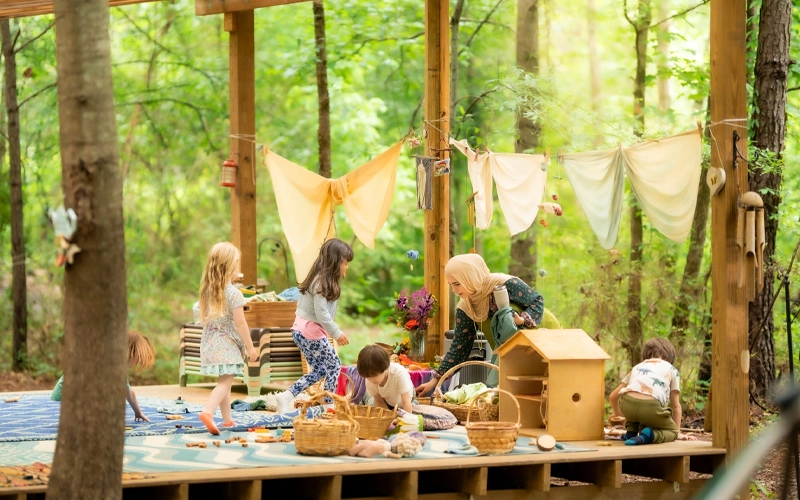
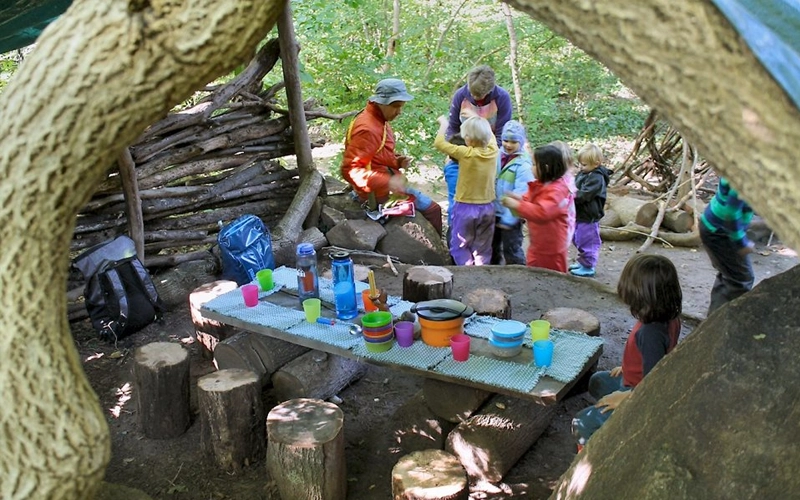
Practical Tips for Setting Up a Waldorf-Inspired Classroom
Setting up a Waldorf classroom requires more than just choosing beautiful furniture. The Waldorf Teaching Method is all about creating an environment that supports each child’s growth—mind, body, and spirit. Here are some practical suggestions for anyone preparing a Waldorf education classroom or preschool:
- Start with a Clear Plan:
Before bringing in any furniture, decide how the Waldorf classroom will be used throughout the day. Consider daily and seasonal rhythms, group activities, quiet corners, and space for movement. Waldorf’s pedagogy values flexibility and flow. - Prioritize Natural Materials:
Select solid wood tables and chairs, cotton or wool rugs, and natural fiber curtains. These materials help make the Waldorf school environment calm, welcoming, and healthy. Avoid plastic or metal when possible to stay true to the Waldorf education philosophy. - Create Defined Zones:
Use shelves and furniture to organize the classroom into areas for play, art, reading, and group work. In the Waldorf Teaching Method, having clear zones supports the unique characteristics of the Waldorf learning method. - Keep Decor Simple and Rhythmic:
Avoid clutter and bold decorations. Instead, display seasonal crafts, nature tables, and soft colors. The Waldorf approach believes that visual rhythm helps children feel secure and inspired. - Use Child-Sized Furniture and Open Storage:
Low tables, chairs, and shelves give children independence. They can reach materials on their own, which is central to Waldorf education schools and the Waldorf teaching philosophy. - Plan for Movement:
Include enough open floor space for circle time, games, and creative activities. The Waldorf education method encourages movement as part of daily routines. - Make Maintenance Easy:
Choose washable covers, sturdy furniture, and storage baskets to keep the classroom organized and clean. The Waldorf Teaching Method values beauty, but it must be practical for busy teachers and active children. - Consult Waldorf Furniture Suppliers:
When in doubt, reach out to suppliers who understand the Waldorf system and can recommend products that fit your vision and the Waldorf curriculum.
Setting up a Waldorf-inspired classroom is an investment in every child’s future. When you use the Waldorf Teaching Method to guide your choices, you create a space where children can thrive, just as Rudolf Steiner and Waldorf schools intended.
Step-by-Step Guide: Setting Up a Waldorf Classroom
Setting up a Waldorf classroom can seem overwhelming at first, but following a straightforward step-by-step process makes it both simple and effective. The Waldorf Teaching Method emphasizes thoughtful planning, natural materials, and flexibility. Here’s a practical guide to help you create a warm and inspiring Waldorf classroom from the ground up:
Step 1: Define the Classroom Purpose and Daily Rhythm
- Decide if the space will be for a Waldorf preschool, kindergarten, or elementary class.
- Sketch out your daily and weekly rhythm, including time for free play, circle time, art, storytelling, and outdoor activities.
- The Waldorf education philosophy values routines and transitions that help children feel secure.
Step 2: Choose a Calm, Light-Filled Space
- Whenever possible, select a room with natural sunlight and good airflow.
- Soft wall colors and simple window coverings support the welcoming Waldorf classroom atmosphere.
- Arrange furniture to take advantage of natural light, and consider adding plants or window crystals.
Step 3: Select Natural, Child-Sized Furniture
- Invest in solid wood tables, child-sized chairs, open shelving, and storage baskets.
- Keep pathways clear and make sure every child can reach supplies independently, following Waldorf pedagogy and supporting independence.
- Place reading corners, art tables, and nature tables where children naturally gather.
Step 4: Organize Activity Zones
- Use shelves or rugs to define zones for building, reading, art, music, and imaginative play.
- Make each area flexible so it can change as children’s interests and classroom needs shift.
- The Waldorf learning method encourages variety—don’t overcrowd, but leave space for movement and discovery.
Step 5: Add Open-Ended Play Materials and Seasonal Decorations
- Include play stands, wooden blocks, silk scarves, Waldorf dolls, and craft supplies.
- Rotate materials and update nature tables or seasonal displays throughout the year to reflect changes in nature.
- The Waldorf approach values beauty and rhythm, so display children’s artwork and handmade decorations.
Step 6: Maintain a Tidy, Organized Space
- Teach children to care for the classroom by putting things away after use.
- Use baskets, trays, and labeled shelves for easy access and clean-up.
- An orderly environment supports the unique characteristics of the Waldorf classroom and the Waldorf Teaching Method.
Step 7: Create a Welcoming Entry and Communicate with Families
- Set up a friendly entrance with a coat rack, shoe shelf, and space for parent communication.
- Display a daily schedule, upcoming events, and seasonal news for families to see.
- The Waldorf education system encourages strong home-school partnerships.
Quick Tips:
- Start simple and build as you go—every Waldorf classroom evolves.
- Involve teachers, children, and parents in decorating and maintaining the space.
- Reach out to Waldorf furniture suppliers for customized solutions that meet your needs.
With careful planning and an open mind, anyone can use the Waldorf Teaching Method to create a classroom where children feel inspired, valued, and ready to learn every day.
Đừng chỉ mơ ước, hãy thiết kế nó! Hãy cùng trò chuyện về nhu cầu nội thất tùy chỉnh của bạn!
Common Mistakes to Avoid in Waldorf Classroom Setup
Setting up a Waldorf classroom can be both exciting and challenging. The Waldorf Teaching Method is unique and even experienced teachers or school leaders can make mistakes if they’re new to Waldorf education. Here are some of the most common pitfalls to avoid:
- Using Too Many Commercial or Plastic Materials
One of the biggest mistakes in Waldorf schools is filling the classroom with brightly colored plastic toys and commercial products. The Waldorf philosophy values natural, simple materials that spark the imagination. Always choose wood, cotton, wool, and other natural fibers for classroom furniture and learning materials. - Quá tải không gian
Trying to fit in too much furniture or too many toys can make the classroom feel cluttered and overwhelming. The Waldorf approach believes in “less is more.” Keep open spaces for movement and free play, and rotate toys and supplies throughout the year instead of displaying everything at once. - Ignoring Rhythm and Routine
Waldorf classrooms need a steady rhythm to help children feel safe and focused. Skipping daily or seasonal routines can make students anxious and disrupt the Waldorf learning method. Plan for regular circle time, storytelling, seasonal crafts, and transitions. - Forgetting the Importance of Nature
Another common mistake is not bringing enough of the natural world into the classroom. An actual Waldorf classroom should reflect the seasons, with nature tables, plants, and seasonal decorations as core features of the Waldorf Teaching Method. - Neglecting Teacher and Student Comfort
Don’t overlook the comfort of teachers and children. Child-sized furniture, soft lighting, and cozy reading areas help everyone feel at home, which is vital for the Waldorf education philosophy. - Skipping Consultation with Experts
Sometimes, schools try to “DIY” a Waldorf setup without consulting those familiar with Waldorf pedagogy. This can lead to poor layout choices or the purchasing of unsuitable products. Work with experienced Waldorf furniture suppliers and educators whenever possible. - Lack of Flexibility
Sticking too rigidly to a room layout or over-planning can limit creativity and natural flow. The Waldorf classroom should evolve as the children grow and change—be ready to adapt your setup as needed.
Avoiding these mistakes helps ensure your Waldorf classroom is a welcoming, creative, and nurturing environment that genuinely supports the Waldorf Teaching Method.
Làm thế nào để kết hợp chương trình giảng dạy Waldorf vào chương trình mầm non của bạn?
Nếu bạn đang cân nhắc áp dụng phương pháp giáo dục Waldorf vào trường mầm non của mình, có một số bước quan trọng cần thực hiện để phù hợp với các nguyên tắc sư phạm Waldorf.
Tạo một lịch trình nhất quán
Các lớp học Waldorf được biết đến với lịch trình có cấu trúc nhưng linh hoạt. Nhịp điệu hàng ngày có thể dự đoán được mang lại cho trẻ em cảm giác an toàn và giúp chúng chuyển đổi suôn sẻ giữa các hoạt động. Thời gian sinh hoạt vòng tròn, kể chuyện và các nhiệm vụ thực hành như nướng bánh hoặc làm vườn nên được tích hợp vào ngày để tạo ra trải nghiệm học tập cân bằng và hấp dẫn.
Phương pháp giảng dạy Waldorf nhấn mạnh rất nhiều vào nhịp điệu và thói quen. Trong trường mẫu giáo Waldorf, trẻ em tuân theo một lịch trình nhất quán, có thể dự đoán được bao gồm thời gian chơi sáng tạo, các nhiệm vụ thực hành, hoạt động nghệ thuật và suy ngẫm trong yên lặng. Nhịp điệu này giúp trẻ em cảm thấy an toàn và vững vàng, tạo nền tảng học tập và phát triển cá nhân vững chắc.
Thêm đồ chơi và đồ nội thất tự nhiên
Triết lý giảng dạy Waldorf nhấn mạnh vào việc sử dụng các vật liệu tự nhiên. Các lớp học Waldorf được trang bị đồ nội thất bằng gỗ, búp bê thủ công và các sợi tự nhiên như len và cotton. Sự đơn giản của các vật liệu này giúp giảm sự kích thích quá mức và khuyến khích trẻ em tham gia sâu hơn vào trò chơi sáng tạo.
Trong trường mẫu giáo Waldorf, môi trường đóng vai trò quan trọng đối với quá trình học tập. Chương trình giảng dạy Waldorf khuyến nghị sử dụng đồ chơi làm từ vật liệu tự nhiên, dễ sờ, đơn giản và mở, cho phép trẻ khám phá và sử dụng trí tưởng tượng của mình một cách tự do. Tránh đồ chơi bằng nhựa hoặc thương mại có thể quyết định cách chơi của trẻ. Thay vào đó, hãy sử dụng đồ chơi cho phép trẻ tham gia vào trò chơi giả vờ, kể chuyện và hợp tác với bạn bè.
Khuyến khích các kỹ năng sống thực tế
Việc đưa các kỹ năng sống như nấu ăn, dọn dẹp và thủ công vào chương trình giảng dạy Waldorf cho phép trẻ phát triển trách nhiệm, tính độc lập và các kỹ năng vận động tinh. Những hoạt động này không chỉ là việc nhà—mà là những trải nghiệm học tập nuôi dưỡng cảm giác hoàn thành và cộng đồng.
Phương pháp giảng dạy Waldorf coi những nhiệm vụ thực tế này là thiết yếu đối với sự phát triển của trẻ. Trong lớp học Waldorf, trẻ em có thể giúp chuẩn bị đồ ăn nhẹ, sắp xếp phòng cho các hoạt động trong ngày hoặc hỗ trợ dọn dẹp sau giờ chơi. Những hoạt động này dạy các kỹ năng sống thiết yếu, thúc đẩy tinh thần đồng đội và mang lại cho trẻ em ý thức trách nhiệm và sự gắn bó trong cộng đồng lớp học.
Khám phá thiên nhiên cùng trẻ em
Chơi ngoài trời là trọng tâm của triết lý giáo dục Waldorf. Cho dù đó là đi bộ trong thiên nhiên, làm vườn hay chơi tự do trong môi trường tự nhiên, những hoạt động này giúp trẻ xây dựng mối liên hệ với thiên nhiên, một thành phần thiết yếu của giáo dục Waldorf. Tiếp xúc thường xuyên với thiên nhiên nuôi dưỡng cảm giác ngạc nhiên, tò mò và trách nhiệm với môi trường.
Trường mẫu giáo Waldorf thường kết hợp các hoạt động theo mùa phản ánh nhịp điệu của thế giới tự nhiên, chẳng hạn như trồng hạt vào mùa xuân, thu thập lá vào mùa thu hoặc xây dựng các tác phẩm điêu khắc tuyết vào mùa đông. Các hoạt động ngoài trời này khuyến khích hoạt động thể chất và giúp trẻ em trân trọng thế giới xung quanh hơn. Thế giới tự nhiên được coi là lớp học tốt nhất trong giáo dục Waldorf, mang đến vô vàn cơ hội để khám phá và học hỏi.
Trường Waldorf khác với trường học thông thường như thế nào?
Giáo dục Waldorf khác biệt với giáo dục truyền thống ở một số lĩnh vực chính, đáng chú ý là phương pháp phát triển, phương pháp học tập và triết lý chung. Sau đây là cách các trường Waldorf khác với các trường thông thường:
- Phương pháp Waldorf có thể áp dụng cho các lớp học hiện đại không?
Phương pháp giáo dục Waldorf không khuyến khích sử dụng công nghệ, trong khi các lớp học hiện đại thường phụ thuộc nhiều vào các công cụ kỹ thuật số. Việc điều chỉnh các nguyên tắc Waldorf để đáp ứng nhu cầu của bối cảnh giáo dục ngày nay là một thách thức mà nhiều trường phải đối mặt. - Phương pháp Waldorf có phù hợp với mọi loại trẻ em không?
Mặc dù phương pháp Waldorf mang tính toàn diện và lấy trẻ làm trung tâm, nhưng nó có thể không phù hợp với tất cả trẻ em, đặc biệt là những trẻ phát triển mạnh trong môi trường học tập có cấu trúc chặt chẽ hơn. - Phương pháp Waldorf giải quyết những khác biệt trong học tập của từng cá nhân như thế nào?
Hệ thống giáo dục Waldorf cho phép trẻ em học theo tốc độ của riêng mình, thúc đẩy tính hòa nhập. Tuy nhiên, việc thiếu các đánh giá chuẩn hóa có thể không cung cấp đủ hỗ trợ cho trẻ em có nhu cầu học tập cụ thể.
Các trường Waldorf thường thu hút những gia đình coi trọng sự sáng tạo, phát triển cảm xúc và tốc độ chậm hơn trong việc giới thiệu học thuật. Tuy nhiên, một số nhà phê bình cho rằng trẻ em trong các trường Waldorf có thể không được chuẩn bị tốt cho các bài kiểm tra chuẩn hóa và sự nghiêm ngặt về mặt học thuật của trường học truyền thống. Hệ thống giáo dục Waldorf được thiết kế để đáp ứng nhu cầu của từng trẻ, nhưng có thể không phù hợp với kỳ vọng của các gia đình tìm kiếm một nền giáo dục có cấu trúc, truyền thống hơn.
Phần kết luận
Việc đưa Phương pháp giảng dạy Waldorf vào trường mầm non của bạn có thể dẫn đến trải nghiệm giáo dục mang tính chuyển đổi, nơi trẻ em phát triển về mặt cảm xúc, trí tuệ và xã hội. Phương pháp Waldorf khuyến khích sự sáng tạo, tính độc lập và tình yêu học tập suốt đời bằng cách tập trung vào học tập thực hành, trải nghiệm và nuôi dưỡng mối liên hệ với thiên nhiên.
Bằng cách áp dụng triết lý Waldorf, bạn có thể tạo ra một môi trường nuôi dưỡng nơi trẻ em phát triển mạnh mẽ về mặt học thuật và trong mọi lĩnh vực của cuộc sống. Những đặc điểm độc đáo của giáo dục Waldorf cung cấp một giải pháp thay thế toàn diện, lấy trẻ làm trung tâm cho giáo dục truyền thống, bồi dưỡng những cá nhân toàn diện, tò mò, sẵn sàng đối mặt với những thách thức trong tương lai. Hệ thống giáo dục Waldorf lý tưởng để nuôi dưỡng những trải nghiệm học tập sâu sắc, có ý nghĩa kéo dài suốt đời, khiến Phương pháp giảng dạy Waldorf trở thành lựa chọn tuyệt vời cho các cơ sở mầm non muốn cung cấp điều gì đó vượt ra ngoài thông thường.
Bằng cách áp dụng Phương pháp giảng dạy Waldorf và điều chỉnh chương trình mầm non của bạn theo các nguyên tắc cốt lõi, bạn có thể tạo ra một môi trường học tập phong phú, hấp dẫn hỗ trợ sự phát triển toàn diện của mọi trẻ em. Phương pháp này đảm bảo rằng trẻ em được chuẩn bị cho trường học và cuộc sống.
Câu hỏi thường gặp
What is a Waldorf school’s main difference?
A Waldorf school follows the Waldorf Teaching Method, focusing on whole-child development through art, imagination, and nature-based activities, rather than early academic drills. This unique approach sets it apart from traditional education models.
Why are natural materials essential?
Waldorf education cherishes wood, wool, cotton, and other natural elements. These sensory-rich materials create calm classrooms that align with the core values of the Waldorf approach and support children’s emotional well-being.
When do children start learning formal academics?
In the Waldorf curriculum, formal reading and writing are introduced around age 7. Before that, children engage in storytelling, handicrafts, and rhythmic play, laying a strong foundation without early academic pressure.
Do Waldorf classrooms include outdoor time?
Yes—outdoor learning is a staple of Waldorf schools. Activities include gardening, nature walks, and seasonal festivals, extending the Waldorf pedagogy beyond the classroom walls.
How can layout support independence?
A well-designed layout includes child-height shelves, open play areas, and flexible seating. This empowers children to access materials, collaborate, and self-direct—key features of the Waldorf education philosophy.
How do I avoid overcrowding a Waldorf classroom?
Stick to simple, open-ended furniture like wooden tables and open shelving, rotate materials over time, and leave enough space for movement. This minimalist “less is more” design honors Waldorf methodology and enhances creativity.

